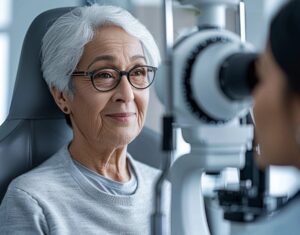
Aging brings a host of changes to our bodies, and the eyes often feel the effects sooner than we’d like. Blurred vision, increased sensitivity to light, and reduced focus on finer details are common challenges. Yet, diet can play a vital role in protecting our vision as we grow older. Nutrient-rich foods can help keep our eyes resilient against aging, supporting overall eye health and potentially reducing the risks of conditions like cataracts and age-related macular degeneration (AMD).
In this article, we’ll explain how a balanced diet rich in essential nutrients can nourish the eyes to maintain visual health and quality of life. We’ll also delve into other eye-friendly diet tips for aging adults.
The Link Between Nutrition and Eye Health
Nutrition and eye health are closely connected. Studies show that certain nutrients can protect the eyes by counteracting harmful processes like oxidative stress and inflammation, which are often responsible for vision decline in older adults. As we age, our eyes are continuously exposed to light and oxygen, making them more vulnerable to oxidative stress—an imbalance between free radicals and antioxidants. This imbalance can damage cells in the eye, contributing to cataracts and AMD. However, the right nutrients can slow or prevent these processes, helping eyes stay strong and resilient.
For those already experiencing vision problems, even those considering having cataract surgery, adopting a nutrient-rich diet could provide protective benefits for maintaining eye health. Let’s explore which nutrients can make a difference.
Key Nutrients for Aging Eyes
Antioxidants: The Protective Shield
Antioxidants are essential for protecting your eyes from oxidative stress, acting like a defense system that guards against cellular damage. Some antioxidants, such as lutein, zeaxanthin, and beta-carotene, are particularly beneficial for eye health.
Lutein and Zeaxanthin
Lutein and zeaxanthin are natural pigments found in the retina that help filter harmful blue light and UV rays, essentially working as a natural sunscreen for your eyes. Research suggests that diets rich in these antioxidants are linked to a reduced risk of AMD and cataracts, as they can reduce oxidative stress in the eye. Foods like spinach, kale, eggs, and corn are excellent sources of lutein and zeaxanthin, making them valuable additions to any diet aimed at supporting eye health.
Beta-Carotene
Another powerful antioxidant, beta-carotene, is converted by the body into vitamin A—a nutrient essential for vision. Vitamin A plays a critical role in maintaining the health of the cornea, the clear layer at the front of the eye, and it supports good night vision by helping the eye’s photoreceptor cells respond to low light conditions. Beta-carotene is abundant in colorful vegetables like carrots, sweet potatoes, and pumpkins, which can all be incorporated into daily meals to give eyes an extra layer of protection.
Essential Vitamins for Vision
Vitamins are essential in maintaining eye health, especially as we age. Each vitamin offers unique benefits, from protecting against cataracts to supporting vision in low-light conditions. Let’s explore a few key vitamins and their impact on eye health.
Vitamin C: Combatting Cataracts
Vitamin C is a potent antioxidant known for its role in reducing the risk of cataracts. This vitamin is highly concentrated in the aqueous humor—the fluid in the front part of the eye—where it helps combat oxidative stress and protect the eye from free radical damage. Research suggests that people who consume diets rich in vitamin C may have a lower risk of cataract formation. Citrus fruits, strawberries, bell peppers, and broccoli are all excellent sources of vitamin C, making it easy to incorporate into daily meals.
For individuals considering cataract surgery or seeking ways to protect their eyes long-term, including vitamin C in their diet may offer benefits that help safeguard their remaining vision. A vitamin C-rich diet can be a practical approach to reducing cataract risk and promoting overall eye health.
Vitamin E: Preventing Cell Damage
Vitamin E is another antioxidant that can help protect the eye’s cells from damage caused by free radicals. This protection is particularly valuable for aging adults, as vitamin E helps reduce the risk of cataracts and AMD. Foods like almonds, sunflower seeds, and leafy greens are rich in vitamin E, making them a convenient addition to an eye-friendly diet. By incorporating these foods into daily meals, individuals can support the health of their eyes over time and promote long-term visual well-being.
Vitamin A: Essential for Night Vision
Vitamin A plays a crucial role in supporting night vision and maintaining the health of photoreceptors—the cells in the retina that detect light. A deficiency in vitamin A can lead to night blindness and, if left unaddressed, even more severe vision problems. Vitamin A is naturally found in foods like liver, dairy products, and orange vegetables such as carrots and sweet potatoes. Regular intake of these foods helps maintain clear vision, particularly in low-light conditions, and supports the overall structure and function of the eye.
Omega-3 Fatty Acids: Lubricating the Eyes
Omega-3 fatty acids, particularly DHA (docosahexaenoic acid), are essential for maintaining the health of cell membranes in the eyes, especially in the retina. These healthy fats have been shown to support several aspects of eye health, from reducing inflammation to promoting a healthy tear film, which can alleviate dry eye symptoms common among aging adults.
Preventing Dry Eye
Dry eye is a frequent issue for many older adults, causing discomfort, itchiness, and blurred vision. Omega-3 fatty acids can help increase tear production and reduce inflammation in the tear glands, alleviating symptoms of dry eye and keeping the eyes moist. Fatty fish such as salmon, sardines, and mackerel are excellent sources of omega-3s, and for those who prefer plant-based options, flaxseeds and walnuts also offer these beneficial fats. Including omega-3s in the diet can make a noticeable difference in eye comfort and overall eye function.
Supporting Retinal Health
The retina contains high levels of DHA, an omega-3 fatty acid that supports retinal health by protecting against oxidative damage and inflammation. DHA is essential for the structural integrity of the retina, and research suggests that a diet rich in omega-3s may help reduce the risk of AMD. This nutrient not only supports day-to-day vision but also provides long-term benefits that can slow the progression of degenerative eye conditions. For those looking to keep their eyes healthy well into their senior years, a diet that includes omega-3-rich foods is an excellent step in the right direction.
Eye-Friendly Diet Tips for Aging Adults
Incorporating eye-healthy nutrients into your diet doesn’t need to be complex. With a few mindful choices, you can ensure your meals provide the vitamins, antioxidants, and omega-3 fatty acids that support vision.
Colorful Plate Variety
Eating a wide variety of colorful fruits and vegetables helps ensure a comprehensive intake of antioxidants and essential vitamins. Dark leafy greens, orange vegetables, and red fruits each offer unique benefits for eye health. By “eating the rainbow,” you can cover a range of nutrients that support and protect your vision.
Include Healthy Fats
Healthy fats play a crucial role in the absorption of fat-soluble vitamins like A and E. Adding sources of healthy fats to your diet can help these essential vitamins work effectively. Drizzle olive oil over salads, snack on nuts, or add avocado to meals. These small additions can significantly boost nutrient absorption, ensuring your eyes benefit fully from your diet.
Consider Supplements
While food is the best source of nutrients, supplements may be a helpful option for those who have difficulty meeting their nutrient needs through diet alone. Omega-3, lutein, and zeaxanthin supplements are widely available and can help bridge any dietary gaps. Consulting with an eye care professional can provide personalized guidance if you’re considering supplements, especially if you’re managing any specific eye health concerns.
Lifestyle Factors That Complement Nutrition for Eye Health
Nutrition is a foundational aspect of eye health, but certain lifestyle practices can amplify its benefits. Here are a few lifestyle habits that complement an eye-healthy diet:
Protecting Eyes from UV Light
Long-term sun exposure can accelerate eye aging, increasing the risk of conditions like cataracts and AMD. Wearing sunglasses with UV protection and a hat when spending time outdoors can help shield your eyes from harmful rays. This small habit can go a long way in preserving eye health over the years.
Staying Hydrated
Hydration is essential for every part of the body, including the eyes. Proper hydration helps keep eyes moist and comfortable, reducing the risk of dry eye. Drinking plenty of water throughout the day, especially as you age, can ensure that your eyes stay well-lubricated and function smoothly.
Regular Eye Exams
Routine eye exams are invaluable for detecting early signs of age-related eye conditions. An eye care professional can monitor your eye health, catch any changes early, and provide guidance on managing your vision as you age. Regular check-ups can help you stay proactive about maintaining eye health and addressing potential issues before they progress.
Nourish Your Eyes for a Brighter Future
Aging doesn’t have to mean a decline in eye health. By incorporating nutrients like antioxidants, omega-3s, and essential vitamins into your diet, you can support your vision and protect against age-related conditions like cataracts and AMD. Combine this nutritious diet with simple lifestyle practices—such as UV protection, regular hydration, and eye exams—and you’re taking important steps to preserve your sight well into your golden years. Embrace these choices, and give your eyes the care they deserve for a lifetime of healthy vision.







